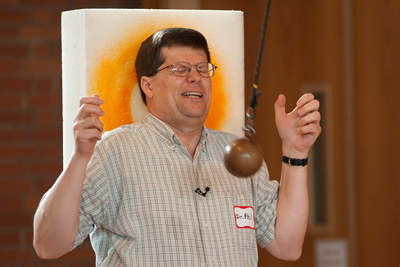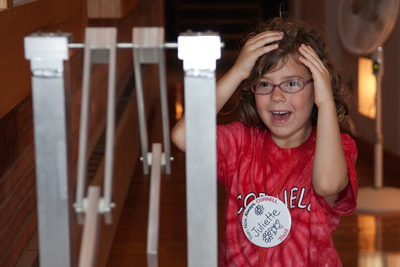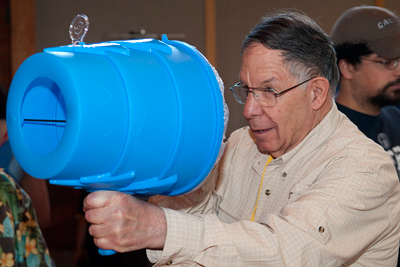Physicist shows off the science, 'not magic,' of physics
By Linda Glaser



"The appeal of any demonstration is directly proportional to the likelihood that the demonstrator will be killed," Phil Krasicky said with a laugh as he set up the bull's-eye target for a pendulum experiment. Krasicky, senior lecturer in physics, has spent more than 20 years collecting hands-on ways to explain physics, and he shared many of them with a Reunion audience June 11 in Schwartz Auditorium.
Krasicky's ability to summarize complex physics in a sentence or two, coupled with his expert showmanship, has made his physics demonstration show one of Reunion's most popular programs. Participants ranged from babes-in-arms to alumni celebrating their 50th reunion.
Before and after the show, participants could try their hand at such gadgets as the gravitational potential well, which spins pennies around a funnel to simulate the effects of a black hole. Electrical generators and chaotic pendulums shared table space with tricks of illusion that had young and old trying to grasp a pink pig and a light bulb that weren't really there (concave mirrors created the mirages).
Krasicky began by declaring, "This is not magic. This is science. This is the way the world really works if you look at it the right way" -- and then proceeded to do a classic "magic" trick, pulling the tablecloth out from under a place setting without disturbing the dishes. "Inertia," said Krasicky. "Objects at rest tend to stay at rest."
The pendulum, Krasicky explained, was often used by professors to demonstrate their faith in the laws of physics. He positioned his head right in front of the bull's-eye, held the pendulum up to his nose, and inconspicuously gave it a good hard push.
He ducked just in time: the pendulum swung back and smashed into the target. Audience members gasped, then eagerly pointed out his mistake -- he'd added energy by pushing the pendulum. The second time, he gently released the pendulum at the tip of his nose, declaring in a progressively higher-pitched voice, "I do believe in physics!" Laughter and cheers erupted from the crowd as this time, the pendulum safely stopped where it had started.
Krasicky demonstrated the relationship between force and acceleration by spinning a full martini glass on a tray in a circle without spilling a drop; the usual Van de Graaff generator performance was enlivened when he put a tray full of Styrofoam peanuts on top and made it "snow" when they exploded upward.
Krasicky demonstrated acoustical principles by dropping sticks on a granite slab to play "Happy Birthday." His grand finale, Cornell's alma mater played on water-filled wine glasses, made haunting, ethereal music that brought spellbound silence to the hall.
After the demonstration, Krasicky's assistants shot pingpong balls into the air for the children to catch; one mother shot smoke rings at her son. Jennifer Vollbrecht-Ludka '90, watching her daughter Juliette experimenting with the spinning wheel on a rotating platform, said "she loves to see it and feel it and do it, so this is really exciting for her."
"We came because my husband and I both started out in sciences and ended up doing something else, but we have a lingering love for the sciences and thought it would also be fun for the kids," said Cindy Crawford '90, who said they had a wonderful time.
A half hour after the demonstration ended, children and adults were still playing with the equipment. One parent, whose 9-year-old refused to leave, offered a bribe: "When you're a freshman at Cornell, you can do this again."
Linda Glaser is a staff writer in the College of Arts and Sciences.
Get Cornell news delivered right to your inbox.
Subscribe